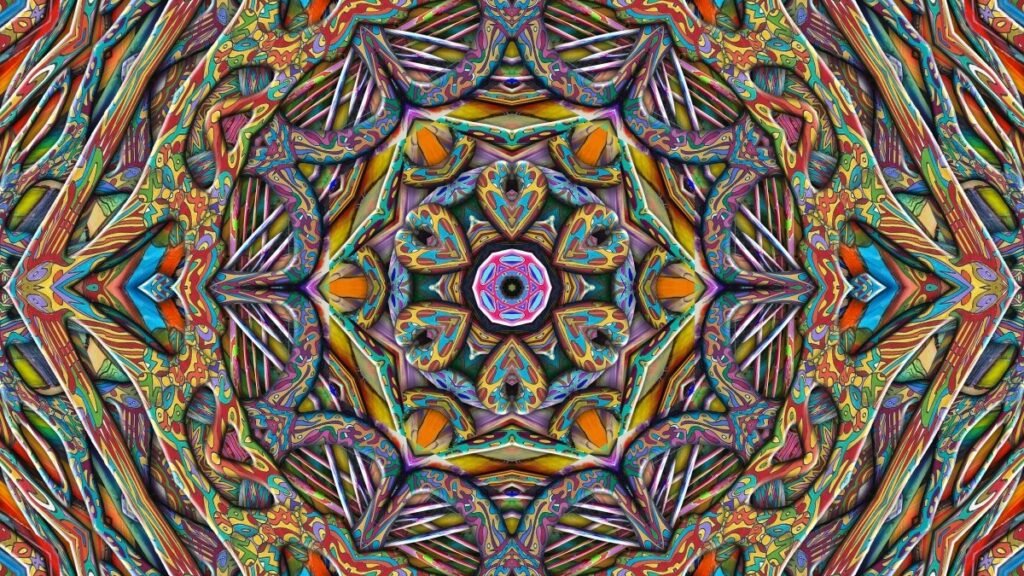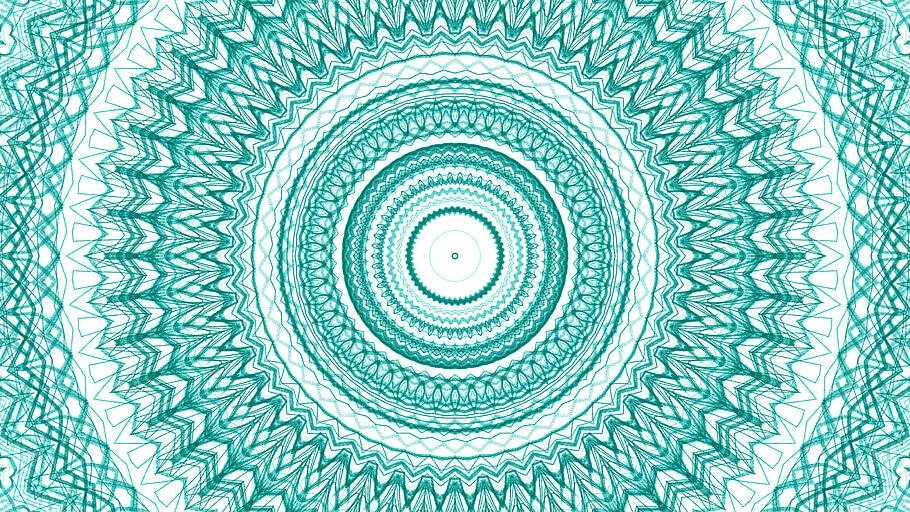What is Mandala Art?

The word “Mandala” comes from Sanskrit, meaning circle or center. At its heart, a mandala is a geometric design that represents the cosmos, spiritual journey, and wholeness.
You’ve likely seen mandalas in temples, meditation spaces, or coloring books. But they’re more than just decorative — they carry deep spiritual and psychological meaning.
A mandala art design usually starts from a center point and flows outward in symmetrical shapes and patterns, symbolizing the journey from the inner self to the universe.
Understanding the Core Meaning of Mandala Art
If you’re wondering what is Mandala Art, the answer goes far beyond beautiful circles and patterns. Mandala Art is a spiritual and symbolic art form that represents wholeness, balance, and harmony. The word “mandala” comes from the ancient Sanskrit language, where it means “circle” or “center.” This simple shape holds deep meaning across various cultures and belief systems.
At its core, the mandala art meaning is about connection—with ourselves, with others, and with the universe. A mandala typically features a geometric arrangement of shapes and patterns that radiate out from a central point. This central point symbolizes your inner self, while the expanding patterns represent your connection with the outer world.
The meaning of mandala can be deeply personal or universally spiritual. In many traditions, it’s used as a tool for meditation, healing, and inner peace.
Mandalas are often used in:
- Buddhist and Hindu rituals
- Spiritual practices and mindfulness exercises
- Modern art therapy and stress relief
One of the most beautiful aspects of mandala art is that anyone can create or experience it. Whether you’re drawing one yourself or admiring someone else’s work, it encourages you to be present, peaceful, and centered.
Mandala Definition in Simple Terms:
A mandala is a circular design made of repeating patterns and symbols, representing unity, spiritual journey, and the cycle of life.
In today’s world, mandalas are not just religious symbols. They appear in coloring books, tattoos, digital art, yoga studio decor, and even fashion—all while keeping their deep symbolic value.
So, the next time someone asks what is mandala art, you can say it’s a visual meditation—a way to reflect, relax, and reconnect.
Symbolism in Mandalas

Mandalas are not just beautiful—they’re filled with deep spiritual and cultural symbolism. Every shape, pattern, and color in a mandala has a special meaning that reflects the inner self, the cosmic order, or even a state of mind.
Common Mandala Symbols and Their Meanings:
🔵 Circle
The most important shape in mandalas. It represents:
- Wholeness and completeness
- The universe and the cycle of life
- Unity between body, mind, and spirit
🌸 Lotus Flower
A sacred symbol in many traditions. It stands for:
- Purity of heart and soul
- Enlightenment and spiritual growth
- Rising above negativity
🔺 Triangles
Depending on direction:
- Upward triangles = action, energy, fire
- Downward triangles = grounding, water, feminine energy
- Used to show transformation and movement in life
🌀 Spirals and Swirls
These shapes symbolize:
- The journey inward and outward
- Expansion of consciousness
- Spiritual evolution and personal growth
The Meaning of Colors in Mandala Art
Colors in mandalas are chosen carefully and carry emotional or spiritual messages. While meanings can vary slightly, here’s a general guide:
- 🔵 Blue – Peace, calm, and wisdom
- 🔴 Red – Strength, energy, and passion
- 🟡 Yellow – Joy, clarity, and intellect
- 🟢 Green – Healing, nature, and balance
- ⚪ White – Purity and spiritual truth
- 🟣 Purple – Spiritual power and transformation
These symbols and colors together give each mandala its own energy and message, making it a powerful tool for meditation, expression, and healing.
Why Mandala Art Matters
While mandalas are rooted in ancient traditions, they continue to hold deep relevance in today’s modern world. The importance of mandala art goes beyond its beauty—it’s a powerful tool for healing, focus, and self-expression.
Here’s why mandala art matters in the modern context:
1. Meditation & Healing
Mandalas are widely used as a meditative tool. The repetitive patterns and circular form help quiet the mind and bring a sense of calm. Whether you’re coloring, drawing, or simply gazing at one, mandalas can:
- Promote inner peace
- Reduce anxiety and stress
- Improve focus and mindfulness
In fact, many spiritual practices use mandala meditation to center the mind and connect with the self.
2. Art Therapy
In art therapy, mandalas are used to help people explore their emotions through visual creation. The act of making a mandala allows individuals to:
- Process trauma and inner conflict
- Express emotions without words
- Gain clarity and emotional release
Therapists often use mandala drawing with children and adults alike to support mental and emotional well-being.
3. Self-Expression & Creativity
Each mandala is as unique as the person creating it. The choice of colors, shapes, and symbols tells a story—your story. Mandalas provide a safe, open space for:
- Exploring creativity
- Reflecting on your inner world
- Personal growth and inspiration
Whether you’re an artist or a beginner, creating mandala art is a form of empowerment through self-expression.
In short, mandala art isn’t just about design—it’s about balance, healing, and connection. That’s why people around the world, from therapists to spiritual seekers, turn to mandalas as a meaningful and mindful practice.
How Mandalas Are Used Around the World
Mandalas are a universal symbol found in many cultures across the globe. Though styles and meanings may differ, their spiritual and artistic importance remains strong.
Here’s a quick look at how mandalas are used worldwide:
- Hinduism: Mandalas are used in religious rituals and temple art to represent the cosmos and divine energy. They serve as spiritual maps guiding meditation and worship.
- Buddhism: Tibetan monks create intricate sand mandalas as a practice of mindfulness, impermanence, and compassion. These mandalas are often destroyed after completion to symbolize life’s transient nature.
- Native Cultures: Many Indigenous peoples incorporate circular designs resembling mandalas in medicine wheels, dreamcatchers, and ceremonial art, symbolizing harmony and connection with nature.
- Modern Mindfulness Practices: Today, mandalas are popular tools in meditation, yoga, and art therapy worldwide, helping people focus, heal, and express themselves creatively.
Mandalas continue to bridge ancient traditions with contemporary spiritual and creative practices, making them a timeless symbol of unity.
Frequently Asked Questions (FAQs) About Mandala Art
What is the simple meaning of Mandala?
A mandala is a circular design that symbolizes wholeness, unity, and balance. It represents the universe and is used as a tool for meditation and spiritual connection.
Is Mandala Art spiritual or religious?
Mandala art has both spiritual and religious roots, especially in Hinduism and Buddhism. However, many people use mandalas today simply for meditation, relaxation, and creative expression without any religious meaning.
Can anyone make a Mandala?
Yes! Anyone can create a mandala, regardless of skill level or background. Making mandalas is a relaxing and personal way to explore creativity and mindfulness.
Why are mandalas always circular?
The circle in a mandala represents completeness and eternity—with no beginning or end. This shape reflects the cycle of life, nature, and the universe, making it perfect for spiritual symbolism.
What is the difference between Mandala and Zentangle?
While both involve creating patterns, mandalas are circular designs with spiritual meaning, often symmetrical and focused on unity. Zentangle is a method of drawing abstract, repetitive patterns that promote relaxation but isn’t necessarily circular or symbolic.